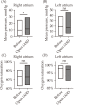Iatrogenic atrial septal defects after transseptal puncture for percutaneous left atrial appendage occlusion and their hemodynamic effects
- PMID: 36284683
- PMCID: PMC9548059
- DOI: 10.11909/j.issn.1671-5411.2022.09.009
Iatrogenic atrial septal defects after transseptal puncture for percutaneous left atrial appendage occlusion and their hemodynamic effects
Abstract
Background: Percutaneous left atrial appendage occlusion (LAAO) requires puncture of the interatrial septum. The immediate hemodynamic effects of iatrogenic atrial septal defects (iASD) after LAAO have not been examined so far. We aimed at evaluating these effects through invasive measurements of pressure and oxygen saturation. Moreover, we assessed the incidence of persistent iASD at three months.
Methods: Forty-eight patients scheduled for percutaneous LAAO were prospectively included in the study. Pressure and oxygen saturation were measured (1) in the right atrium (RA) before transseptal puncture, (2) in the left atrium (LA) through the transseptal sheath after transseptal puncture, (3) in the LA after removal of introducer sheath, and (4) in the RA after removal of introducer sheath. Transesophageal echocardiography was performed at three months to detect iASD.
Results: Pressure in the RA increased significantly after removing the introducer sheath (P = 0.034), whereas no difference was found in oxygen saturation in the RA (P = 0.623). Pressure measurement in the LA showed no significant difference after removing the introducer sheath (P = 0.718). Oxygen saturation in the LA also showed no significant difference (P = 0.129). Follow-up transesophageal echocardiogram at 3 months revealed a persistent iASD in 4 patients (8.5 %).
Conclusions: Our study suggests that iASD after percutaneous LAAO does not result in significant shunts directly after the procedure, although a significant increase of mean right atrial pressure can be observed. Persistent iASDs after percutaneous LAAO seem to be relatively rare at three months.
© 2022 JGC All rights reserved; www.jgc301.com.
Figures
References
-
- Benjamin EJ, Muntner P, Alonso A, et al Heart disease and stroke statistics-2019 update: a report from the american heart association. Circulation. 2019;139:e56–e528. - PubMed
-
- Hindricks G, Potpara T, Dagres N, et al 2020 ESC Guidelines for the diagnosis and management of atrial fibrillation developed in collaboration with the European Association for Cardio-Thoracic Surgery (EACTS): The Task Force for the diagnosis and management of atrial fibrillation of the European Society of Cardiology (ESC) Developed with the special contribution of the European Heart Rhythm Association (EHRA) of the ESC. Eur Heart J. 2021;42:373–498. doi: 10.1093/eurheartj/ehaa612. - DOI - PubMed
LinkOut - more resources
Full Text Sources

